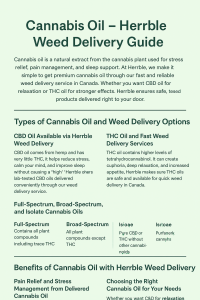🌿 Comprehensive Scientific and Practical Guide to Cannabis
Cannabis is a plant with a long-standing history in both medicinal and recreational use. Whether you’re seeking relief from chronic pain, looking to sleep better, or reduce anxiety, this plant offers a diverse range of effects thanks to its unique chemical composition. This article provides a deep dive into cannabis structure, effects, innovative consumption methods, product highlights, and cultivation practices—enhanced with strategic internal links from Herrble.ca.
🔬 Cannabinoids and Terpenes: The Heart of Cannabis Effects
The two most prominent compounds in cannabis are THC (tetrahydrocannabinol) and CBD (cannabidiol). THC is primarily responsible for the psychoactive effects, while CBD is known for its calming, anti-inflammatory, and anti-seizure properties. These compounds, along with terpenes, shape the overall user experience. Terpenes—such as myrcene, limonene, and linalool—contribute to aroma, flavor, and therapeutic impact. Learn more in this detailed guide on cannabis terpenes.
🧠 Psychological, Physical, and Therapeutic Effects
Depending on the strain and consumption method, cannabis may enhance mood, aid concentration, relieve pain, reduce muscle spasms, and alleviate nausea. It is increasingly used in conditions like epilepsy, MS, PTSD, and chronic anxiety. In cases resistant to traditional medication, combining THC with CBD can yield positive therapeutic outcomes.
💊 Methods of Consumption: Traditional and Modern
Consumers can choose from smoking, vaping, edibles, oils, and sublingual methods. Sublingual cannabis—explained in this article—offers fast-acting effects and controlled dosing, making it popular for those seeking quick relief without inhaling smoke.
🌿 How to Choose the Best Cannabis Strain for Personal Use
Choosing the right strain depends on your goals (medical or recreational), tolerance level, and flavor/aroma preferences. Indicas are known for relaxation and pain relief. Sativas are energizing and uplifting. Hybrids blend effects based on their genetic makeup. Beginners may prefer low-THC/high-CBD strains, while experienced users might seek high-THC products.
🛍️ Popular Cannabis Products
Hash remains one of the most potent and diverse cannabis products. Free Weed Delivery Toronto. Herrble.ca offers premium options like:
🌱 Cultivation, Cloning, and Cannabis Plant Training
Interested in growing cannabis at home? Master techniques like topping, pruning, and cloning. These enhance yield, health, and potency. Start with this article on topping and trimming your plants, and learn about effective replication in this cloning guide.
📦 Mail Order and Delivery Services
Herrble offers reliable mail-order weed delivery Toronto, with discreet packaging, fast shipping, and helpful customer support. Explore their special deals section for daily offers and bonuses.
🧾 Final Thoughts
Understanding cannabis—both scientifically and practically—can help users make safe, informed, and fulfilling choices. For the best experience, consider your tolerance, desired effects, and product quality. Herrble.ca is your trusted partner for education, premium products, and nationwide delivery.







